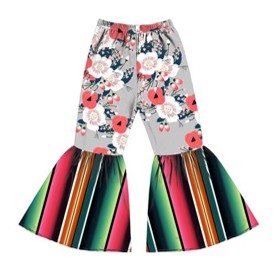Kids Pants Size Chart
| Size | Age (years) | Height (inches) | Weight (pounds) | Hips (inches) | Waist (inches) | Inseam (inches) |
|---|---|---|---|---|---|---|
| 2 T | 2 | 33.5 to 35 | 30 to 32 | 20.5 to 21 | 20.5 to 21 | 14 to 14.75 |
| 3 T | 3 | 35 to 38 | 32 to 35 | 21 to 22 | 21 to 21.5 | 14.75 to 15.5 |
| 4 T | 4 | 38 to 41 | 35 to 39 | 22 to 23 | 21.5 to 22 | 15.5 to 17 |
| 5 T | 5 | 41 to 44 | 39 to 45 | 23 to 24 | 22 to 22.5 | 17 to 18.75 |
| Kids Pants Size Guide Chart Maker : iSizeChart.com | ||||||
| US Size | UK size (years) | AU Size (inches) | EU Size (pounds) |
|---|---|---|---|
| 2 | 2 to 3 | 3 | 92 to 98 cm |
| 3 | 3 to 4 | 4 | 98 to 104 cm |
| 4 | 4 to 5 | 5 | 104 to 110 cm |
| 5 | 5 to 6 | 6 | 110 to 116 cm |
| Kids Pants Size Chart Maker : iSizeChart.com | |||
About Kids Pants Size Guide Chart
How to choose the fabric for kids pants?
Choosing the right fabric for kids' pants is crucial for comfort, durability, and health. Here’s a detailed guide to help you pick the best materials:
1. Prioritize Natural, Breathable Fabrics.
Cotton (100% or blends). Pros: Soft, breathable, hypoallergenic, and gentle on sensitive skin. Ideal for everyday wear. Look for: Organic cotton (free from pesticides) or combed cotton (softer finish). Best for: All seasons, especially hot weather.
Linen. Pros: Highly breathable, moisture-wicking, and antibacterial. Cons: Wrinkles easily and can feel rough (opt for linen-cotton blends for kids). Best for: Summer pants.
Bamboo. Pros: Silky-soft, naturally antimicrobial, and thermoregulating (keeps kids cool or warm). Cons: Often blended with cotton or spandex for durability. Best for: Sensitive skin or eczema-prone babies.
2. Synthetic Blends (Use Sparingly).
Polyester or Nylon Blends (10–30% max). Pros: Adds stretch and durability (e.g., for leggings or joggers). Cons: Traps heat/sweat; avoid 100% synthetic fabrics. Tip: Look for moisture-wicking finishes if used for sportswear.
Spandex/Elastane (5–10%). Pros: Adds flexibility for crawling/playing. Common in "stretchy" pants.
3. Avoid These Fabrics.
Rough or Stiff Fabrics: Denim (unless stretchy and lined), burlap, or heavy wool (can itch).
Chemically Treated Fabrics: Avoid fabrics labeled "wrinkle-resistant" or "stain-repellent" (may contain PFAS).
4. Seasonal Considerations.
Winter: Fleece-lined cotton, soft wool blends (merino wool is less itchy), or thermal knits.
Rainy/Cold Weather: Water-resistant outer layers (e.g., nylon with a breathable membrane).
5. Key Features to Check.
Weave: Knit fabrics (like jersey) are softer and stretchier than woven fabrics (like twill).
Certifications: Look for OEKO-TEX® (no harmful chemicals) or GOTS (organic standards).
6. Special Cases.
For Active Kids: Moisture-wicking blends (e.g., cotton-modal-spandex) for playgrounds or sports.
Pro Tips:
Wash Before Use: Removes residual chemicals or stiffness from new clothes.
Feel the Fabric: Rub it against your cheek to test softness. If it feels scratchy, it’ll irritate a child’s skin.
Check Seams: Flatlock stitching prevents chafing.
